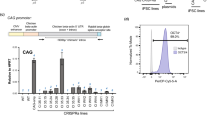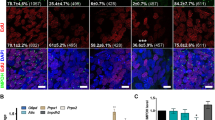Abstract
MSCs possess the capacity of self-renewal and potential of differentiation into various kinds of specialized tissue cells including myocardiocytes. From self-renewing to oriented differentiation, chromatin is remodeled into heritable states that allow activation or maintain the repression of regulatory genes, which means specific genes in self-renewing switched off and specific genes in oriented differentiation activated (Bernstein et al. Cell 125:315–326, 2006). These epigenetic states are established and controlled largely by specific patterns of histone posttranslational modifications, in particular, histone acetylation (Li Nat Rev Genet 3:662–673, 2002). In cardiomyocyte differentiation of rat MSCs, we focused on Gcn5, which linked a known transcriptional coactivator with catalytic histone acetyltransferase activity (Brownell et al. Cell 84:843–851, 1996). To clarify participatory in vivo role of Gcn5, using an RNA interference (RNAi) strategy employing shRNA to specifically knockdown Gcn5 expression in MSCs, we found that HAT activity altered dynamically depended on the inhibition of Gcn5 during MSCs differentiation. Chromatin immunoprecipitation (ChIP) assay showed the increased binding of acetyl histone H3 to the early cardiomyocyte-specific genes GATA4 and NKx2.5 promoters in cardiomyocyte differentiation of MSCs by 5-azacytidine inducing, whereas the decreased binding with lower Gcn5 expression. Cell ultrastructure analysis revealed that MSCs induced by 5-azacytidine possess morphological characteristics of cardiomyocyte cells. The shape of MSCs transfected by Gcn5 RNAi was similar to normal MSCs, but the chromatin showed heavy electron-density and a hard-packed structure. This intermediate state of chromatin may be an inactive part of MSCs differentiation. These results demonstrate that Gcn5, possessing acetyltransferase activity, is involved in regulating chromatin configuration around GATA4 and NKx2.5 in cardiomyocyte differentiation of rat MSCs by changing the level of histone acetylation. HAT activity depending on Gcn5 is important in differentiation of MSCs into cardiomyocytes as a consequence of the remodeling of the chromatin configuration caused by modification of histone H3.





Similar content being viewed by others
References
Liu Y, Song J, Liu W et al (2003) Growth and diferentiation of rat bone marrow stromal cells: does 5-azacytidine trigger their cardiomyogenic diferentiation? Cardiovasc Res 58:460–468
Li E (2002) Chromatin modification and epigenetic reprogramming in mammalian development. Nat Rev Genet 3:662–673
Benayahu D, Shefer G, Shur I (2008) Insights into chromatin remodelers in mesenchymal stem cells and differentiation. J Front Biosci 14:398–409
Grant PA, Duggan L, Côté J et al (1997) Yeast Gcn5 functions in two multisubunit complexes to acetylate nucleosomal histones: characterization of an Ada complex and the SAGA (Spt/Ada) complex. Genes Dev 11:1640–1650
Barbaric S, Walker J, Schmid A et al (2001) Increasing the rate of chromatin remodeling and gene activation—a novel role for the histone acetyltransferase Gcn5. EMBO J 20:4944–4951
Filetici P, Aranda C, Gonzalez A et al (1998) GCN5, a yeast transcriptional coactivator, induces chromatin reconfiguration of HIS3 promoter in vivo. Biochem Biophys Res Commun 242:84–87
Qiu H, Hu C, Yoon S et al (2004) An array of coactivators is required for optimal recruitment of TBP and RNA polymerase II by promoter-bound Gcn4p. Mol Cell Biol 24:4104–4117
Geng F, Laurent BC (2004) Roles of SWI/SNF and HATs throughout the dynamic transcription of a yeast glucose-repressible gene. EMBO J 23:127–137
Govind CK, Yoon S, Qiu H et al (2005) Simultaneous recruitment of coactivators by Gcn4p stimulates multiple steps of transcription in vivo. Mol Cell Biol 25:5626–5638
Wang L, Mizzen C, Ying C et al (1997) Histone acetyltransferase activity is conserved between yeast and human GCN5 and is required for complementation of growth and transcriptional activation. Mol Cell Biol 17:519–527
Takahashi K, Yamanaka S (2006) Induction of pluripotent stem cells from mouse embryonic and adult fibroblast cultures by defined factors. Cell 126:663–676
Li L, Zhu J, Tian J (2008) Effects of histone acetylation on differentiation of mesenchymal stem cells. Zhonghua Yi Xue Yi Chuan Xue Za Zhi 25:159–163
Kuo MH, Brownell JE, Sobel RE et al (1996) Tetrahymena histone acetyltransferase A: a homolog to yeast Gcn5p linking histone acetylation to gene activation. Cell 84:843–851
Guarente L (1995) Transcriptional coactivators in yeast and beyond. Trends Biochem Sci 20:517–521
Wang L, Liu L, Berger SL (1998) Critical residues for histone acetylation by Gcn5, functioning in Ada and SAGA complexes, are also required for transcriptional function in vivo. Genes Dev 12:640–653
Gregory PD, Schmid A, Zavari M et al (1998) Absence of Gcn5 HAT activity defines a novel state in the opening of chromatin at the PHO5 promoter in yeast. Mol Cell 1:495–505
Brownell JE, Zhou J, Ranalli T, Kobayashi R et al (1996) Tetrahymena histone acetyltransferase A: a homolog to yeast Gcn5p linking histone acetylation to gene activation. Cell 84:843–851
Georgakopoulos T, Thireos G (1992) Two distinct yeast transcriptional activators require the function of the GCN5 protein to promote normal levels of transcription. EMBO J 11:4142–4152
Brand T (2003) Heart development: molecular insights into cardiac specification and early morphogenesis. Dev Biol 258:1–19
Valiunas V, Doronin S, Valiuniene L et al (2004) Human mesenchymal stem cells make cardiac connexins and form functional gap junctions. J Physiol 555:617–626
Jenuwein T (2001) Re-SET-ting heterochromatin by histone methyltransferases. Trends Cell Biology 11:266–273
Bernstein BE, Mikkelsen TS, Xie X et al (2006) A bivalent chromatin structure marks key developmental genes in embryonic stem cells. Cell 125:315–326
Acknowledgments
This work was supported by the National Natural Science Foundation of China (Grant Number: 30670871 and 30901621).
Author information
Authors and Affiliations
Rights and permissions
About this article
Cite this article
Li, L., Zhu, J., Tian, J. et al. A role for Gcn5 in cardiomyocyte differentiation of rat mesenchymal stem cells. Mol Cell Biochem 345, 309–316 (2010). https://doi.org/10.1007/s11010-010-0586-3
Received:
Accepted:
Published:
Issue Date:
DOI: https://doi.org/10.1007/s11010-010-0586-3




